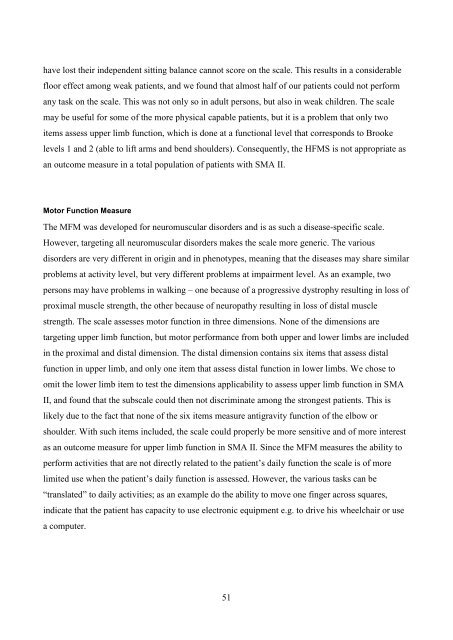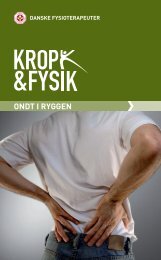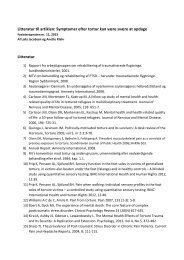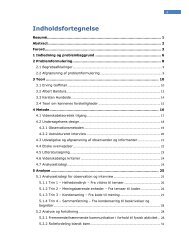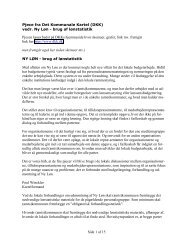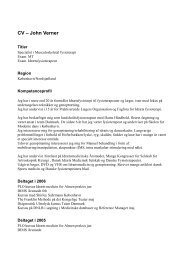Ulla Werlauff Methods to assess physical functioning - Danske ...
Ulla Werlauff Methods to assess physical functioning - Danske ...
Ulla Werlauff Methods to assess physical functioning - Danske ...
Create successful ePaper yourself
Turn your PDF publications into a flip-book with our unique Google optimized e-Paper software.
have lost their independent sitting balance cannot score on the scale. This results in a considerable<br />
floor effect among weak patients, and we found that almost half of our patients could not perform<br />
any task on the scale. This was not only so in adult persons, but also in weak children. The scale<br />
may be useful for some of the more <strong>physical</strong> capable patients, but it is a problem that only two<br />
items <strong>assess</strong> upper limb function, which is done at a functional level that corresponds <strong>to</strong> Brooke<br />
levels 1 and 2 (able <strong>to</strong> lift arms and bend shoulders). Consequently, the HFMS is not appropriate as<br />
an outcome measure in a <strong>to</strong>tal population of patients with SMA II.<br />
Mo<strong>to</strong>r Function Measure<br />
The MFM was developed for neuromuscular disorders and is as such a disease-specific scale.<br />
However, targeting all neuromuscular disorders makes the scale more generic. The various<br />
disorders are very different in origin and in phenotypes, meaning that the diseases may share similar<br />
problems at activity level, but very different problems at impairment level. As an example, two<br />
persons may have problems in walking – one because of a progressive dystrophy resulting in loss of<br />
proximal muscle strength, the other because of neuropathy resulting in loss of distal muscle<br />
strength. The scale <strong>assess</strong>es mo<strong>to</strong>r function in three dimensions. None of the dimensions are<br />
targeting upper limb function, but mo<strong>to</strong>r performance from both upper and lower limbs are included<br />
in the proximal and distal dimension. The distal dimension contains six items that <strong>assess</strong> distal<br />
function in upper limb, and only one item that <strong>assess</strong> distal function in lower limbs. We chose <strong>to</strong><br />
omit the lower limb item <strong>to</strong> test the dimensions applicability <strong>to</strong> <strong>assess</strong> upper limb function in SMA<br />
II, and found that the subscale could then not discriminate among the strongest patients. This is<br />
likely due <strong>to</strong> the fact that none of the six items measure antigravity function of the elbow or<br />
shoulder. With such items included, the scale could properly be more sensitive and of more interest<br />
as an outcome measure for upper limb function in SMA II. Since the MFM measures the ability <strong>to</strong><br />
perform activities that are not directly related <strong>to</strong> the patient’s daily function the scale is of more<br />
limited use when the patient’s daily function is <strong>assess</strong>ed. However, the various tasks can be<br />
“translated” <strong>to</strong> daily activities; as an example do the ability <strong>to</strong> move one finger across squares,<br />
indicate that the patient has capacity <strong>to</strong> use electronic equipment e.g. <strong>to</strong> drive his wheelchair or use<br />
a computer.<br />
51


